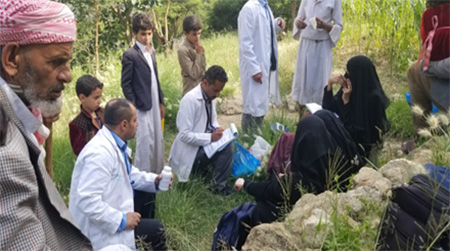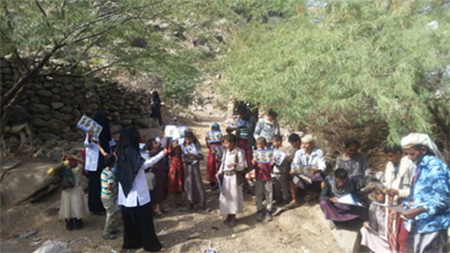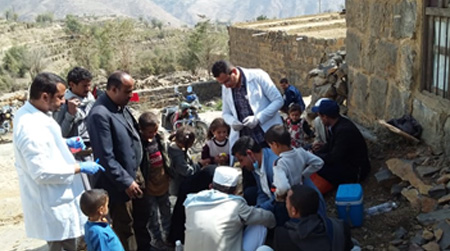 Sana’a, 2 June 2022 – Every country needs a strong health workforce to monitor and respond quickly to any increase in cases of infectious diseases. The world saw this clearly during the COVID-19 pandemic and it is a key lesson to take forward.
Sana’a, 2 June 2022 – Every country needs a strong health workforce to monitor and respond quickly to any increase in cases of infectious diseases. The world saw this clearly during the COVID-19 pandemic and it is a key lesson to take forward.
WHO and World Bank partnership on eIDEWS and rapid response teams
In Yemen, every year, cases of cholera, dengue, diphtheria, malaria, measles, and other diseases are reported. To support the authorities to rapidly detect and respond to these threats, WHO and the World Bank have worked together in partnership since 2017 through the Emergency Health and Nutrition Project (EHNP).
 The WHO Representative to Yemen, Dr Adham Rashad Ismail Abdel-Moneim shared an example of the project’s success: “When the EHNP started there were around 1000 surveillance sites across 306 districts in Yemen. One year later the number of sites had doubled and expanded to all 333 districts in the country. By 2020, there were 2378 sites all regularly reporting via eIDEWS”.
The WHO Representative to Yemen, Dr Adham Rashad Ismail Abdel-Moneim shared an example of the project’s success: “When the EHNP started there were around 1000 surveillance sites across 306 districts in Yemen. One year later the number of sites had doubled and expanded to all 333 districts in the country. By 2020, there were 2378 sites all regularly reporting via eIDEWS”.
The EHNP also enabled significant upgrading of Yemen’s electronic Integrated Disease Early Warning System (eIDEWS). The platform is now completely digital and standardizes line lists, investigation forms and response forms as well as summarizing key information into visual dashboards.
Responding to the world’s largest cholera outbreak
During the largest cholera outbreak the world had ever seen, in Yemen in 2016–2017, rapid response teams (RRTs) were established in every district with the World Bank’s support. They were equipped with mobile phones and tablets to report through eIDEWS so that data from the field could be made available to decision-makers. The 333 RRTs were made up of five members: a doctor or medical assistant, health educator, surveillance officer, laboratory officer and district health officer. They were supported and supervised by 23 governorate teams and two central teams in Sana’a and Aden.
 The RRTs played a critical role in containing the cholera outbreak and their value as first responders to infectious disease alerts was soon realized. Over time the remit of the RRTs expanded to cover more than 20 infectious diseases. Through the EHNP, almost 1800 RRT team members and 3000 surveillance officers have undergone training to build their skills and knowledge in disease surveillance and response. They are now an integral part of Yemen’s health system.
The RRTs played a critical role in containing the cholera outbreak and their value as first responders to infectious disease alerts was soon realized. Over time the remit of the RRTs expanded to cover more than 20 infectious diseases. Through the EHNP, almost 1800 RRT team members and 3000 surveillance officers have undergone training to build their skills and knowledge in disease surveillance and response. They are now an integral part of Yemen’s health system.
Tackling challenges together: COVID-19
When COVID-19 struck in 2020, the RRT model was used to quickly establish 670 COVID-19 teams. These two-person teams were deployed within 24 hours to investigate any alerts about suspected COVID-19 cases. They worked closely with the 333 RRTs who continued to monitor and respond to the myriad of infectious diseases in Yemen. This two-pronged approach of routine and COVID-19 specific RRTs enabled the surveillance system to be sustained even while COVID-19 dominated global attention.
The World Bank played a pivotal role by partnering with WHO on the Yemen COVID-19 Response Project (YCRP) in April 2020. The Bank was the first donor to support the COVID-19 response in Yemen, providing $27 million to WHO. These funds were crucial in activating the COVID-19 RRTs, establishing 48 isolation units across the country, dramatically scaling-up PCR testing to 18 laboratories, and procuring lifesaving supplies and equipment. In July 2021, the Bank again showed its leadership in pandemic response, providing an additional $20 million for Yemen to rollout the COVID-19 vaccines and reinforce health system capacities towards building back better.
Looking to the future: investing in human capital
Now as the focus on COVID-19 fades, Yemen is responding to outbreaks of polio, measles, and pertussis serving as constant reminders of the need to invest in routine immunization and preparedness and response. Eight years of conflict have taken a disastrous toll on the country, but by staying engaged the World Bank’s support to WHO has prevented the collapse of Yemen’s health system. Through the new Emergency Human Capital Project (EHCP), which is the successor to the EHNP, WHO and the World Bank are investing in building institutional and individual capacities.
Launching the intermediate Field Epidemiology Training Program (FETP)
One key activity of the EHCP, which builds on investments in eIDEWS, RRTs and the COVID-19 response, is a year-long intermediate Field Epidemiology Training Program (FETP).
FETP is renowned globally for building national epidemiological capacities. More than 80% of graduates continue to work in their home countries in leadership positions. In Sana’a, for example, the Director of Disease Surveillance and Response is a former FETP graduate.
This month 40 candidate health workers were selected from among hundreds across Yemen to compete for 25 places in the intermediate FETP course. They will build skills in public health data management and outbreak response, and they will do on-the-job field projects towards strengthening surveillance systems, all while continuing with their day jobs. At the launch of the course, the FETP Coordinator, Dr Yasser Ahmed Abdrehim Ghaleb stressed to the participants “in future, Yemen will count on you to rapidly investigate and respond to outbreaks.”








